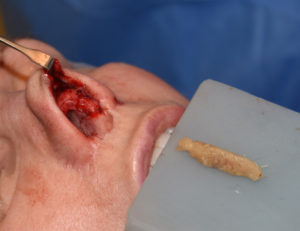A significant build-up of the nose requires a combination of bridge and tip augmentation. In primary rhinoplasty this is usually needed in many ethnic patients who lack nasal projection from the face. This may also be required in revision rhinoplasty when over reduction has been done from a prior procedure. In such cases the key element of the surgery is an adequate volume of cartilage grafts.
The most common source of an undisputed volume of cartilage is a rib graft. The ribs offers an unlimited amount of cartilage for the nose no matter where on the ribcage it is harvested. Despite this huge advantage, rib cartilage has a major disadvantage….it is not straight. Nowhere on the rib cage is a cartilaginous section perfectly straight. In addition it almost always has to be carved, removing perichondrium in the process. This further potentiates the risk of graft warping after surgery.

Diced rib grafting offers not only a customizable approach to significant nasal augmentation but a rapid integration/healing of the graft. The many small cartilage pieces allow for early and substantial fibrovascular ingrowth into the graft. This is evidenced by the very firm feel of the diced rib graft just a few weeks after the procedure.
Dr. Barry Eppley
Indianapolis, Indiana


